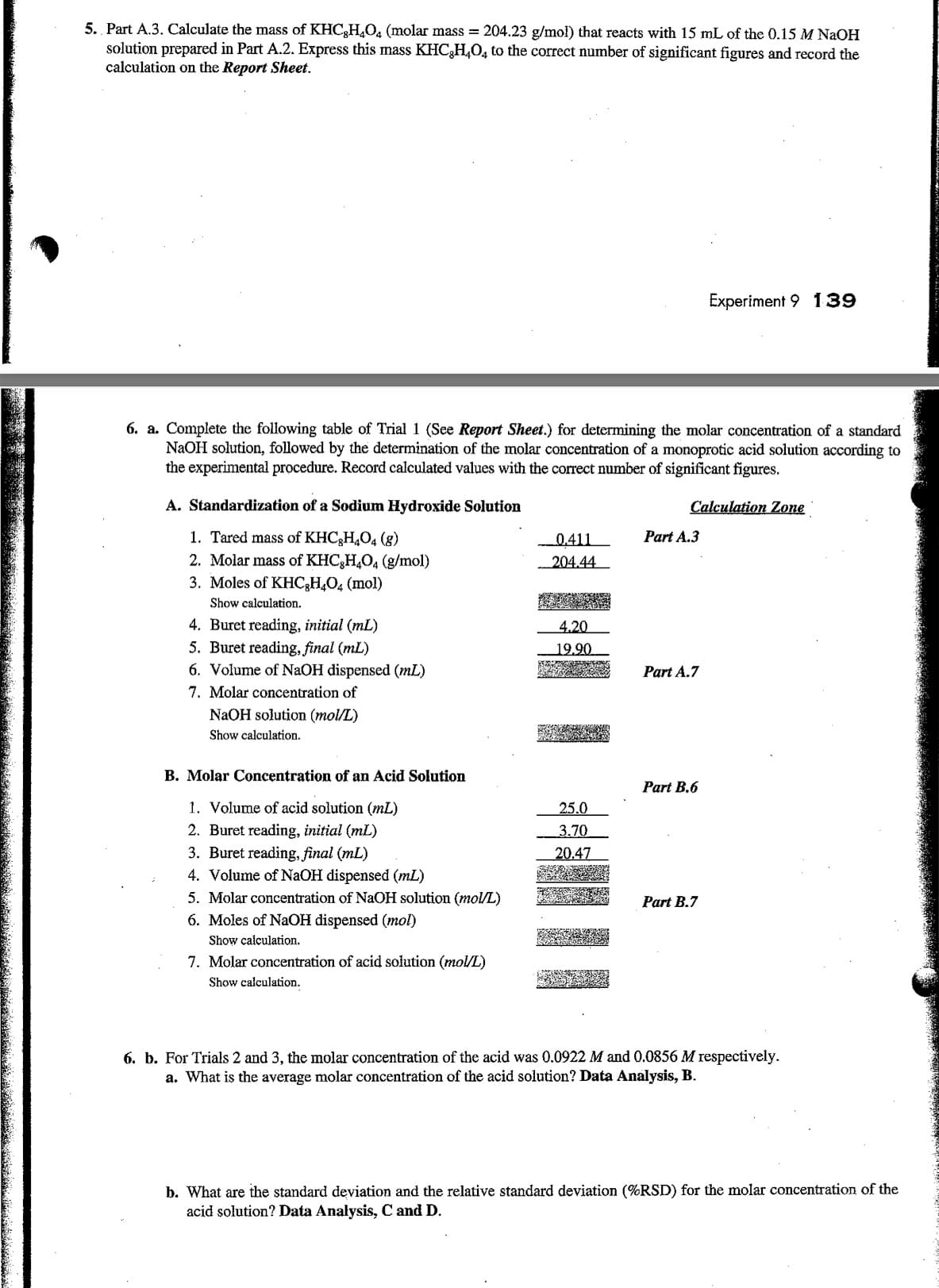5. Part A.3. Calculate the mass of KHC8H4O4 (molar mass=204.23 g/mol) that reacts with 15 mL of the 0.15 M NaOH solution prepared in Part A.2. Express this mass KHC,H4O4 to the correct number of significant figures and record the calculation on the Report Sheet.
5. Part A.3. Calculate the mass of KHC8H4O4 (molar mass=204.23 g/mol) that reacts with 15 mL of the 0.15 M NaOH solution prepared in Part A.2. Express this mass KHC,H4O4 to the correct number of significant figures and record the calculation on the Report Sheet.
Chemistry
10th Edition
ISBN:9781305957404
Author:Steven S. Zumdahl, Susan A. Zumdahl, Donald J. DeCoste
Publisher:Steven S. Zumdahl, Susan A. Zumdahl, Donald J. DeCoste
Chapter1: Chemical Foundations
Section: Chapter Questions
Problem 1RQ: Define and explain the differences between the following terms. a. law and theory b. theory and...
Related questions
Question

Transcribed Image Text:5. Part A.3. Calculate the mass of KHC,H₂O4 (molar mass=204.23 g/mol) that reacts with 15 mL of the 0.15 M NaOH
solution prepared in Part A.2. Express this mass KHC,H,O, to the correct number of significant figures and record the
calculation on the Report Sheet.
6. a. Complete the following table of Trial 1 (See Report Sheet.) for determining the molar concentration of a standard
NaOH solution, followed by the determination of the molar concentration of a monoprotic acid solution according to
the experimental procedure. Record calculated values with the correct number of significant figures.
A. Standardization of a Sodium Hydroxide Solution
1. Tared mass of KHC H₂O4 (g)
2. Molar mass of KHC8H4O4 (g/mol)
3. Moles of KHC3H₂O4 (mol)
Show calculation.
4. Buret reading, initial (mL)
5. Buret reading, final (mL)
6. Volume of NaOH dispensed (mL)
7. Molar concentration of
NaOH solution (mol/L)
Show calculation.
B. Molar Concentration of an Acid Solution
1. Volume of acid solution (mL)
2. Buret reading, initial (mL)
3. Buret reading, final (mL)
4. Volume of NaOH dispensed (mL)
5. Molar concentration of NaOH solution (mol/L)
6. Moles of NaOH dispensed (mol)
Show calculation.
7. Molar concentration of acid solution (mol/L)
Show calculation.
0.411
204.44
Z
4.20
19.90
ses
25.0
3.70
20.47
N
Calculation Zone
Part A.3
Part A.7
Experiment 9 139
Part B.6
Part B.7
6. b. For Trials 2 and 3, the molar concentration of the acid was 0.0922 M and 0.0856 M respectively.
a. What is the average molar concentration of the acid solution? Data Analysis, B.
b. What are the standard deviation and the relative standard deviation (%RSD) for the molar concentration of the
acid solution? Data Analysis, C and D.
Expert Solution
This question has been solved!
Explore an expertly crafted, step-by-step solution for a thorough understanding of key concepts.
This is a popular solution!
Trending now
This is a popular solution!
Step by step
Solved in 3 steps with 6 images

Knowledge Booster
Learn more about
Need a deep-dive on the concept behind this application? Look no further. Learn more about this topic, chemistry and related others by exploring similar questions and additional content below.Recommended textbooks for you

Chemistry
Chemistry
ISBN:
9781305957404
Author:
Steven S. Zumdahl, Susan A. Zumdahl, Donald J. DeCoste
Publisher:
Cengage Learning

Chemistry
Chemistry
ISBN:
9781259911156
Author:
Raymond Chang Dr., Jason Overby Professor
Publisher:
McGraw-Hill Education

Principles of Instrumental Analysis
Chemistry
ISBN:
9781305577213
Author:
Douglas A. Skoog, F. James Holler, Stanley R. Crouch
Publisher:
Cengage Learning

Chemistry
Chemistry
ISBN:
9781305957404
Author:
Steven S. Zumdahl, Susan A. Zumdahl, Donald J. DeCoste
Publisher:
Cengage Learning

Chemistry
Chemistry
ISBN:
9781259911156
Author:
Raymond Chang Dr., Jason Overby Professor
Publisher:
McGraw-Hill Education

Principles of Instrumental Analysis
Chemistry
ISBN:
9781305577213
Author:
Douglas A. Skoog, F. James Holler, Stanley R. Crouch
Publisher:
Cengage Learning

Organic Chemistry
Chemistry
ISBN:
9780078021558
Author:
Janice Gorzynski Smith Dr.
Publisher:
McGraw-Hill Education

Chemistry: Principles and Reactions
Chemistry
ISBN:
9781305079373
Author:
William L. Masterton, Cecile N. Hurley
Publisher:
Cengage Learning

Elementary Principles of Chemical Processes, Bind…
Chemistry
ISBN:
9781118431221
Author:
Richard M. Felder, Ronald W. Rousseau, Lisa G. Bullard
Publisher:
WILEY